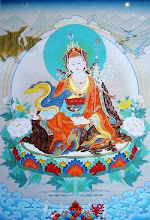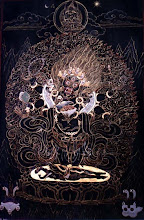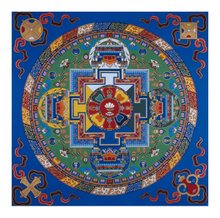
When interacting with others, much of our visual attention is directed towards the face. So, too, when we look at thangka. We tend to pick out the face, not so much because it can tell us about the deity, but from the habit of directing attention there and because the face is usually the center piece of the composition. It's one spot in the painting that requires symmetrical precision and a steady hand, a spot where so much is conveyed – about the subject as well as the painter – in a few simple lines.
There are, I have heard, thangka artists who specialize in faces, guys who command a premium wage for being able to draw the finely balanced lines required for a compelling, life-like face. I won't be one of them soon.
I was nervous about doing the face. As you may have noticed I left it to last. I didn't want to do the face early, do it poorly, and then have to look at every day. That might have been too discouraging. I was hoping, too, that as I completed the painting my hand would become more facile and I would in turn develop more confidence to undertake its painting.
Unfortunately, I took ill this past week, first with hay fever, then with a head cold, and I lost a bit of the physical and mental momentum I had built up over the preceding weeks. When it came time to do the face, I wasn't feeling very confident.
I thought about asking someone else to do it for me. It's not uncommon at art school for students to ask their classmates to help them out in areas where they are weak. Sometimes this can be helpful, but I think overall it's better that students practice themselves. They won't always be able to depend on a classmate and they can't become genuine painters until they can do everything themselves.
So I told myself it was up to me, not someone else, and after a good night's rest I went in to school on Friday and finished the face during the morning session. It wasn't the best face I ever painted, but neither was it the worst. At first I cringed, but from a distance it actually didn't look too bad. The only part I hadn't finished were the eye balls. This is generally one of the last tasks of the painting, opening the eyes of the deity. It's perhaps the most difficult part of the the face. At least it has been for me.
As I had grown used to my not-quite-perfect face, I thought it might be best to ask my teacher to open the eyes. I thought perhaps it was best to leave bad enough alone, and I also thought it might be a nice gesture toward my teacher.
He came and sat down in front of my painting. He looked but didn't say anything. Then he asked my classmate Tsering, sitting next to me, for something. She left and came back with some white paint. The teacher meanwhile had left and came back with a saucer, which he proceeded to use as a palette to mix the acrylic white with a bit of yellow. He still hadn't said anything, but I understood he was going to make some corrections. We normally paint in water-based colors; acrylic is easier to paint over and can be used as a masking paint for making touch-ups.
I wish I had taken a photo.
The teacher began applying the acrylic to the edges of the face and I thought he was going to cover up the shading. But he was simply defining the outer edges, and once he had he started pulling down in broad strokes to paint over the eyes, the nose, the mouth, the ears. His intention, still unannounced, was to repaint the entire face.

I'm not sure why he did this. Perhaps he thought the work was too bad to let pass, though I've seen worse from other students, so perhaps he believed he was doing me a kindness by improving my painting. I thought about asking him, but didn't want to insult or make him feel I was unhappy or upset. I was at first a bit surprised, particularly that he hadn't first consulted me. But once done, it was done and there was no use being angry or upset. It was a good lesson for next time, to just go ahead and do the work myself.
So, now I've got a thangka with a beautifully formed face - and a story to tell about it.

As the teacher began the Buddha's facial make-over late Friday afternoon, he didn't get around to finishing until Saturday morning. Once the face was done, he then added the mantra on the back, the five syllables in Tibetan, each written in a particular location.

Forehead – om
Throat – ah
Chest – hum
Navel – so
Genitals – ha

All that was left was then to cut the painting from out of the larger canvas, trim the edges with a straight edge – and then try to summarize the experience to those of my classmates who came out to offer congratulations and inquire about my future intentions for painting.
#

























GJ,Jeff!!! Congratulations!
ReplyDeleteI think your first thangka looks wonderful. Look forward to seeing the real painting soon.
Mutsumi
Congrads Cuz....looking very good indeed!
ReplyDeleteI too am looking forward to seeing it up close!
Ran
Omedeto gozaimasu!!!
ReplyDeleteIt`s nice to see happines in the 2 faces of buddha in the above photograph.
Gassho!
Senpo